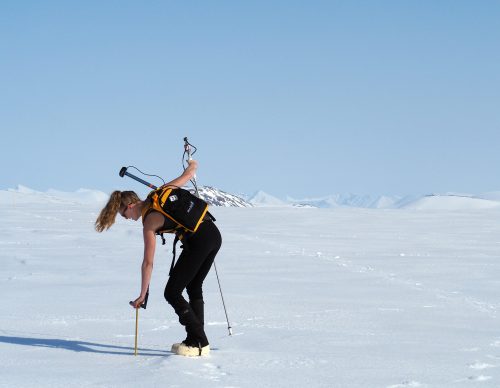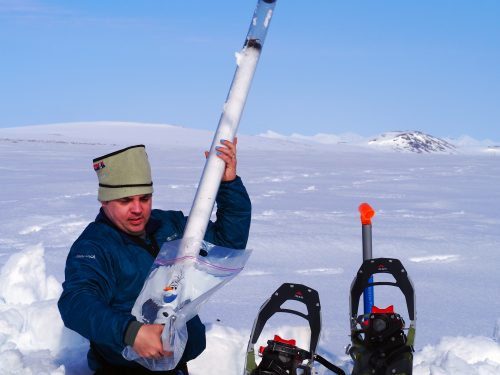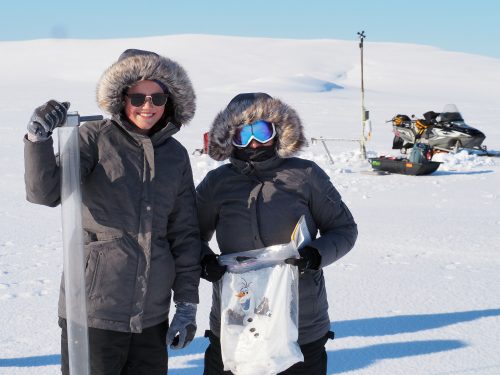From wet to dry, a question to improve global climate models
May 9, 2019
Heather McFarland
907-474-6286

Arctic researchers traveled to western Alaska last month to gather snow depth data, which they believe may be a missing link needed to improve how global climate models predict changing Arctic conditions.
Rapid warming is transforming the Arctic, triggering a cascade of changes across entire ecosystems. Scientists are grappling with how to incorporate degrading permafrost, the expansion of northern shrubs and disturbances such as wildfires into global climate models.
University of Alaska Fairbanks researchers are collaborating with several U.S. Department of Energy national laboratories on a project called Next-Generation Ecosystem Experiments Arctic to improve predictions of Arctic environmental change.
“Our goal is to measure it, translate data into equations, and incorporate those into computer models,” said NGEE Arctic director Stan Wullschleger in a recent interview.
One important question NGEE Arctic is exploring is where, when and why the Arctic is becoming wetter or dryer, and what the implications are for the climate system. The answer could improve how models represent carbon, energy and water processes in the Arctic.
“Current global climate models aren’t built to transition from a very wet environment to a very dry environment,” said hydrologist Bob Bolton from UAF’s International Arctic Research Center. “They currently don’t represent these big landscape transitions.”
In some areas of the Arctic, that is exactly what is happening. Degrading permafrost can cause the ground to slump and ponds to form, making the environment wetter. In other places, the permanently frozen ground thaws, the ground more easily drains and the landscape becomes drier.
Although it sounds bizarre, thawing permafrost isn’t just a summer problem. Winter and snow play a role too.

“It’s all about insulation,” Bolton said. “Snow insulates either warmer or colder.” The amount depends, in part, on how early and deeply the snow accumulates each autumn and how rapidly it melts each spring.
An early snowfall in autumn may trap summer heat in the ground, giving permafrost more time to degrade even as outside temperatures drop. The opposite is true with a late snowfall in spring. If the ground refreezes after the snowfall, additional cold can be trapped in the surface soils, delaying summer thaw.
However, snow is extremely variable across the Arctic, and depths can be difficult to predict. An unsuspecting winter traveler may suddenly plunge from knee-deep to waist-deep snow in only a few steps.
What makes snow accumulate in some areas but not others? To find out, Bolton and colleagues at Los Alamos National Laboratory are painstakingly inventorying the snow pack across multiple study sites near Nome.
It is becoming clear that shrubs play a big part. They trap snow, and that deeper snow adds insulation.
“We have hints that in shrubby areas the permafrost is either completely degraded or degrading much more rapidly than in non-shrubby areas,” said Bolton.
The interconnected nature of the Arctic makes NGEE Arctic’s multidisciplinary expertise valuable. With researchers at Oak Ridge, Los Alamos, Brookhaven and Lawrence Berkeley national laboratories, as well as UAF, the team is well prepared to explore the complexity of vegetation ecology, biogeochemistry and hydrology across the Arctic system.
“We knew going in that we were going to study certain processes, such as vegetation dynamics and the microbial production of carbon dioxide and methane. But, as it turns out, all of those processes are coupled and interconnected,” explained Wullschleger.

The multidisciplinary environment gets Bolton excited about field work.
“I enjoy spending time in the field talking science and bouncing ideas back and forth,” he said. “Stan’s a veg guy. We have different perspectives. He looks at a shrub much differently than I do. I just see it as a thing on the landscape that traps snow.”
In addition to the challenges of understanding a complex and changing ecosystem, NGEE Arctic faces the challenge of gathering data during the winter at a site accessible only by snowmachine or helicopter.
Weather conditions can abruptly shift, so NGEE Arctic crews always prepare to spend the night in the field. Field safety officer Bob Busey, an engineer at the International Arctic Research Center, makes sure crews are as safe and comfortable as possible.
“My role first is to make sure that everybody stays safe, and then my second role is that we collect as high of quality of data as possible,” said Busey. He packs a large safety kit for the field site, complete with an Arctic Oven tent and wood stove, but even the helicopter and personal backpacks receive smaller versions.
Busey’s field philosophy goes beyond just physical safety. He focuses on creating a healthy atmosphere by encouraging friendliness, humor, adequate sleep, upfront communication and the occasional gourmet gummy bear.
NGEE Arctic is funded by the Office of Biological and Environmental Research in the U.S. Department of Energy’s Office of Science.


